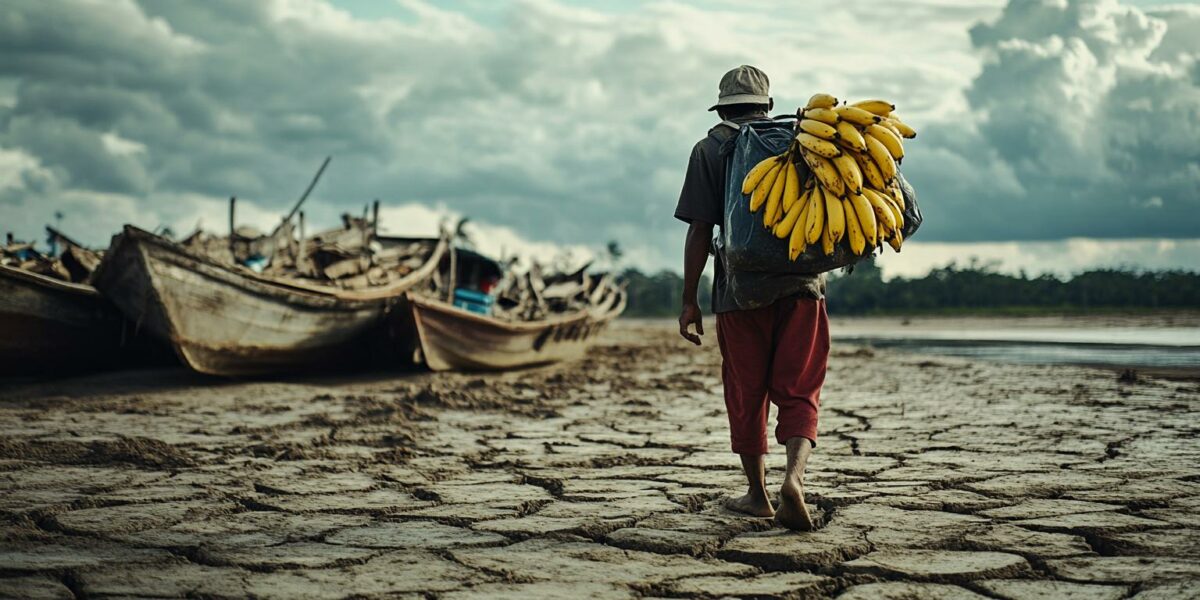Unprecedented Water Crisis in the Amazon
The Rio Negro, a crucial Amazon tributary, has plunged to its lowest depth in over a century. This shocking drop is attributed to ongoing drought conditions exacerbated by climate change, creating significant environmental and economic challenges in the region. The situation in Manaus highlights the severity of this crisis.
Historical data from the Geological Service of Brazil reveals that the river reached a depth of just 12.66 meters, marking a new record low. This alarming figure surpasses previous records and suggests a troubling trend as the dry season persists, potentially leading to further decreases in water levels.
The Rio Negro is not just any river; it ranks as the sixth largest in the world by average discharge. Its unique blackwater, colored by decaying plant matter, is an integral part of the Amazon’s ecosystem. However, prolonged drought conditions have caused this mighty waterway to shrink drastically.
Scientists attribute this to climate change, which has intensified the typical dry-season patterns, leaving riverbeds exposed and causing boats to be stranded. This environmental shift poses a dire threat to the region’s delicate balance and biodiversity.
Impact on Local Communities
The drought’s repercussions extend beyond the environment, affecting over 40 million people who depend on the Amazon’s waterways for survival. The lack of sufficient water threatens access to essential resources like drinking water, food, and transportation, complicating everyday life.
Local businesses, particularly in areas like Puraquequara, are feeling the pinch. According to a restaurant owner, the economic impact has been severe, with basic food items becoming scarce. The once-bustling riverfront now resembles a barren landscape, drastically altering routines.
- Revenue drops due to decreased customer visits
- Scarcity of essential goods and services
- Disruption in transportation and supply chains
Adding to the crisis, researchers have discovered freshwater dolphins stranded along riverbanks, unable to survive the stress of the drought. This highlights the broader ecological consequences of such unprecedented water shortages.
Widespread Drought Across Brazil
The challenges faced by the Amazon are mirrored across Brazil, with reports indicating that 59 percent of the country is grappling with drought conditions. The scope of this environmental disaster is unmatched, stretching from the North to the Southeast regions.
The National Center for Monitoring and Early Warning of Natural Disasters has declared this the most intense and widespread drought in Brazil’s recorded history. This alarming development underscores the need for urgent attention and adaptive strategies to mitigate the impacts.
As the drought persists, the strain on local economies and food systems reliant on the rivers for fishing and agriculture continues to grow. Communities are struggling to adapt to these new realities, facing the dual challenges of environmental and economic instability.
With water levels continuing to drop, the situation in the Amazon serves as a stark reminder of the far-reaching effects of climate change. The ongoing drought highlights the urgent need for innovative solutions to safeguard the region’s future.
Future Prospects and Concerns
As the dry season advances, experts predict that the Rio Negro’s water level could fall even lower, raising concerns about the long-term impacts on the Amazon ecosystem. This potential scenario poses a significant threat to biodiversity, livelihoods, and regional stability.
In response to the crisis, 62 municipalities in the state of Amazonas have declared a state of emergency. This official acknowledgment of the drought’s severity paves the way for coordinated efforts to address the immediate and future challenges.
The Amazon’s plight is a stark example of the tangible effects of climate change on a global scale. It emphasizes the need for robust environmental policies and international cooperation to combat the growing threat of climate-induced disasters.
While the current situation underscores the fragility of natural systems, it also serves as a call to action for developing sustainable practices that can withstand the pressures of a changing climate. The resilience of the Amazon and its people depends on these vital efforts.



genesis_raven
I can’t believe 59% of Brazil is in drought. Are there any international efforts to assist?
EllieArtemis
This is so sad to hear. Thanks for shedding light on such an important issue.
josiahvelocity
How are the local communities adapting to these changes? Are there any innovative solutions being implemented?
WilliamMidnight
Oh boy, yet another reason to worry about our planet. What’s next? Alien invasion? 😅
Isaac
Why isn’t the Rio Negro’s plight getting more media attention? This seems like a big deal!
evanunity
Wow, that restaurant owner must be having a tough time. I hope the government steps in to help these businesses.
max
Can this drought affect global food prices? It sounds like a major crisis in the making.
Paisley_Wisp6
Oh no, not the dolphins! They should have a superhero rescuing them. 🐬
OliverWhisperer
This is a serious wake-up call. We need more drastic action on climate change before it’s too late!
cooper_illusionist2
Isn’t it incredible how climate change is impacting every corner of the world? What are we doing to help regions like the Amazon? 🌍